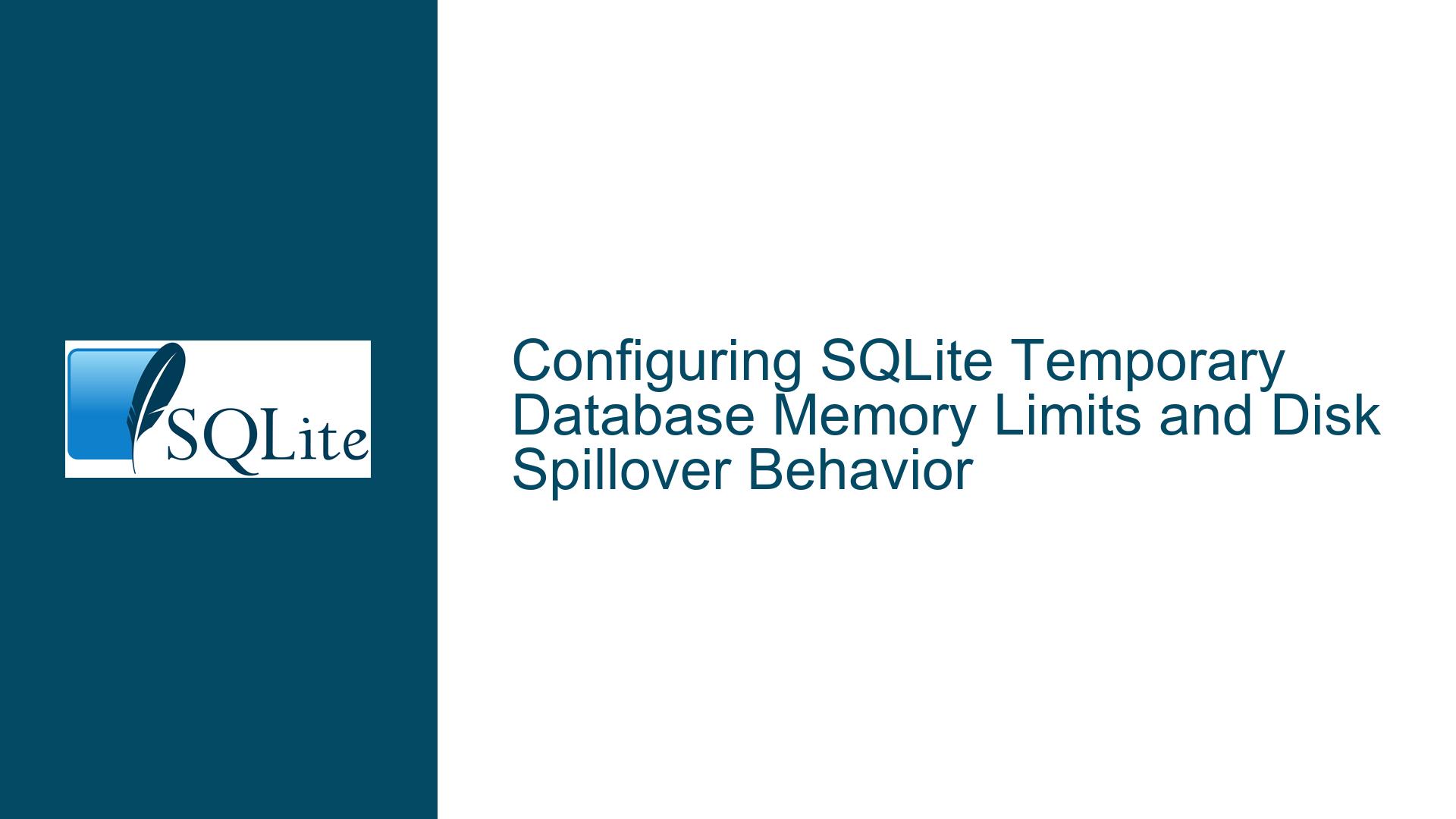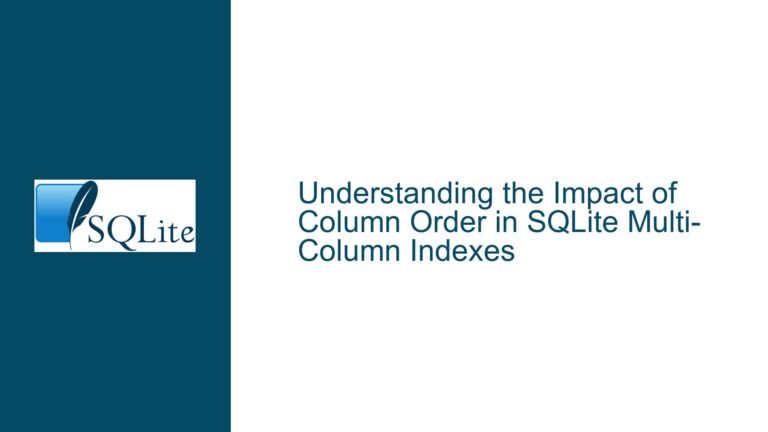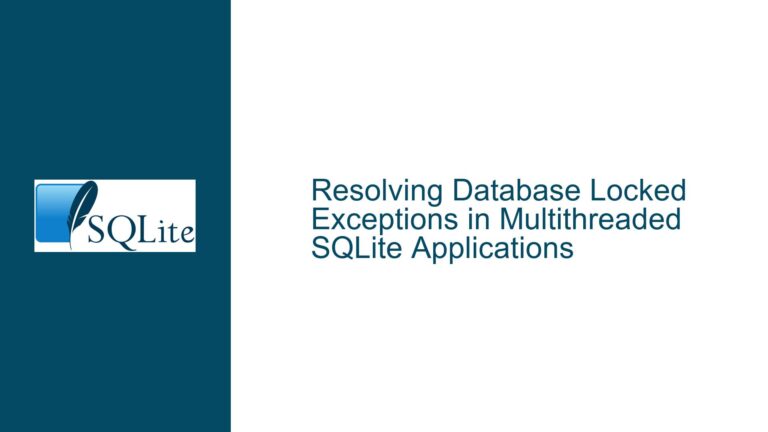Configuring SQLite Temporary Database Memory Limits and Disk Spillover Behavior
Understanding SQLite Temporary Databases, Memory Constraints, and Disk Overflow Mechanisms
Issue Overview: Temporary Database Memory Management and Spillover Expectations
The core issue revolves around configuring an SQLite temporary database to limit its memory consumption while ensuring excess data is automatically flushed to disk. The user’s objective is to create an in-memory-like database that does not exceed a specific memory threshold (e.g., X GB) and spills over to disk when that threshold is reached. However, confusion arises from conflating the concepts of in-memory databases (:memory:) and temporary databases (empty filename), as well as misunderstanding how SQLite manages memory and disk storage for temporary databases.
SQLite’s temporary database is designed to behave like an in-memory database but with the ability to offload parts of the data to disk when memory pressure exists or the database grows beyond a certain size. This behavior is distinct from a pure in-memory database, which never persists to disk. The user attempted to enforce a memory limit using PRAGMA max_page_count but encountered a "database or disk is full" error during data insertion. This indicates a misconfiguration or misunderstanding of how SQLite’s memory management and temporary storage interact.
Key points of confusion include:
- Memory Usage vs. Database Size: Limiting the database size (via
max_page_count) does not directly cap memory consumption. SQLite’s memory usage includes page caches, prepared statements, and other runtime structures, which are separate from the database file’s size. - Temporary Database Behavior: While temporary databases can spill to disk, this is contingent on SQLite’s internal algorithms and system memory availability, not a user-defined threshold.
- Configuration Granularity: SQLite does not provide a direct mechanism to limit memory usage for a specific database. Instead, global or connection-level memory constraints (e.g., heap limits) must be applied.
The user’s error ("database or disk is full") stems from setting max_page_count to 100, which restricts the temporary database to 100 pages. If each page is 4 KB (the default size), this limits the database to 400 KB. Inserting data beyond this limit triggers the error because the database cannot expand further—even if disk space is available. This reveals a critical misunderstanding: max_page_count restricts the total size of the database (in-memory or on-disk), not the memory consumed by SQLite during operation.
Possible Causes: Misconfigurations and Conceptual Misalignments
Incorrect Use of
PRAGMA max_page_count
This pragma sets the maximum number of pages allowed in the database file. For a temporary database, this includes both in-memory and on-disk portions. If set too low, the database cannot grow beyond the specified page count, leading to insertion errors. It does not control memory usage directly.Confusing Temporary Databases with Pure In-Memory Databases
A temporary database (opened with an empty filename) starts in memory but may spill to disk. An in-memory database (:memory:) never spills to disk. The user likely intended to use a temporary database but expected it to behave like a constrained in-memory database with spillover, which is not how SQLite operates.Heap and Page Cache Misconfiguration
SQLite’s memory usage is influenced by:- Page Cache: The number of pages cached in memory per connection.
- Heap Memory: General-purpose memory for query execution, sorting, etc.
Without configuring these (viaPRAGMA soft_heap_limit,PRAGMA hard_heap_limit, or compile-time options), SQLite may consume more memory than desired.
JDBC Wrapper Limitations
Thesqlite-jdbcdriver (e.g., Xerial) may not expose low-level memory configuration APIs likesqlite3_config(), limiting the ability to set global memory policies.Operating System and Runtime Constraints
The Java Virtual Machine (JVM) imposes its own memory limits. If the JVM’s heap is constrained, SQLite may encounter allocation failures, but this is separate from SQLite’s internal memory management.
Troubleshooting Steps, Solutions, and Configuration Fixes
Step 1: Clarify Temporary Database vs. In-Memory Database
- Temporary Database: Created with an empty filename (e.g.,
jdbc:sqlite:). Starts in memory but spills to disk as needed. The spillover is managed by SQLite’s internal algorithms, not a user-defined memory threshold. - In-Memory Database: Created with
:memory:URI. Never spills to disk; all data resides in RAM.
Actionable Fix:
Use a temporary database for spillover behavior. Do not set max_page_count unless you intend to limit the total size of the database.
Step 2: Configure Database Size Appropriately
If limiting the database size is necessary (e.g., for disk space management):
- Calculate the desired database size in pages. For example, a 1 GB limit with a 4 KB page size requires 262,144 pages (
1 GB / 4 KB). - Set
max_page_countat runtime:PRAGMA max_page_count = 262144; - Verify the current size with
PRAGMA page_count;.
Pitfall: This restricts the entire database, not just the in-memory portion. Exceeding this limit will always cause an error, even if disk space is available.
Step 3: Control Memory Usage via Heap Limits
To limit SQLite’s total memory usage:
- Set a soft heap limit:
PRAGMA soft_heap_limit = <bytes>;SQLite will attempt to stay below this limit but may exceed it temporarily.
- Set a hard heap limit (requires SQLite 3.43+):
PRAGMA hard_heap_limit = <bytes>;This aborts queries if the limit is exceeded.
Example:
// Using sqlite-jdbc
SQLiteConfig config = new SQLiteConfig();
config.setPragma(SQLiteConfig.Pragma.SOFT_HEAP_LIMIT, "104857600"); // 100 MB
Connection conn = DriverManager.getConnection("jdbc:sqlite:", config.toProperties());
Step 4: Optimize Page Cache and Memory Allocation
Adjust the page cache size to balance performance and memory usage:
PRAGMA cache_size = <pages>;
For example, cache_size = 2000 limits the cache to 2000 pages (8 MB with 4 KB pages).
Advanced Configuration:
- Use
sqlite3_config(SQLITE_CONFIG_PAGECACHE, ...)in C to preallocate a fixed-size page cache. - In Java, this may require native code or a wrapper that exposes these settings.
Step 5: Monitor Memory Usage Accurately
Tools and methods to monitor SQLite’s memory usage:
- SQLite PRAGMAs:
PRAGMA page_count;: Current database size in pages.PRAGMA freelist_count;: Number of unused pages.
- Process-Level Monitoring:
- On Linux:
ps -o rss= -p <PID>(resident set size). - On Windows: Task Manager’s "Memory" column.
- On Linux:
- Java-Specific Tools:
- VisualVM, JConsole, or
Runtime.totalMemory()to track JVM heap usage.
- VisualVM, JConsole, or
Critical Insight: SQLite’s memory usage is part of the host process’s memory (e.g., the JVM). If the JVM is limited to 512 MB, SQLite cannot exceed this, regardless of its internal settings.
Step 6: Address the "Database or Disk is Full" Error
This error occurs when:
- The database file (in-memory or on-disk) reaches
max_page_count. - The disk partition is full.
Solutions:
- Increase
max_page_countif the database size limit is too restrictive. - Ensure the temporary directory (e.g.,
/tmpon Unix) has sufficient space.
Step 7: Leverage Temporary Disk Storage Effectively
SQLite’s temporary database uses the following directories for spillover:
- Unix:
/var/tmp,/usr/tmp, or/tmp(in order). - Windows:
%TEMP%environment variable.
Configuration:
- Set the
SQLITE_TMPDIRenvironment variable to a dedicated directory with sufficient space. - Use
PRAGMA temp_store = FILE;to force temporary objects (e.g., indices, tables) to disk.
Step 8: Validate Spillover Behavior
To confirm that SQLite is spilling to disk:
- Monitor the temporary directory for SQLite-generated files (e.g.,
etilqs_*). - Use
PRAGMA temp_store_directory;(deprecated) or check the OS-specific temp directory.
Example Test:
// Insert data until spillover occurs
Statement stmt = conn.createStatement();
stmt.execute("PRAGMA temp_store = DEFAULT;");
stmt.execute("CREATE TABLE test (data TEXT);");
try {
for (int i = 0; i < 1_000_000; i++) {
stmt.execute("INSERT INTO test VALUES (randomblob(1024));"); // Insert 1 KB per row
}
} catch (SQLException e) {
System.out.println("Error: " + e.getMessage());
}
Monitor the temp directory for files. If none appear, the data is still in memory.
Step 9: Adjust Expectations for Automatic Spillover
SQLite does not provide fine-grained control over when spillover occurs. The engine moves data to disk based on:
- Available memory (as reported by the OS).
- Internal caching algorithms.
- Query complexity (e.g., large sorts may use temporary indices on disk).
Workaround: For predictable spillover, manually partition data into in-memory and disk-based tables.
Step 10: Compile SQLite with Custom Memory Settings
For advanced control, compile SQLite with non-default options:
- SQLITE_CONFIG_HEAP: Allocate a fixed-size memory heap.
- SQLITE_CONFIG_PAGECACHE: Preallocate a page cache pool.
Example:
sqlite3_config(SQLITE_CONFIG_HEAP, malloc(1024 * 1024 * 100), 100 * 1024 * 1024, 64);
This creates a 100 MB heap with 64-byte alignment.
Final Solution Summary
To achieve a temporary database with constrained memory usage and disk spillover:
- Avoid
max_page_countunless you need to limit the database’s total size. - Set
soft_heap_limitorhard_heap_limitto control SQLite’s memory consumption. - Monitor the JVM/process memory to ensure external constraints are not the bottleneck.
- Rely on SQLite’s automatic spillover while ensuring sufficient disk space in the temp directory.
By aligning configuration with SQLite’s design and leveraging heap limits, users can approximate the desired behavior of a memory-constrained temporary database with disk spillover.





